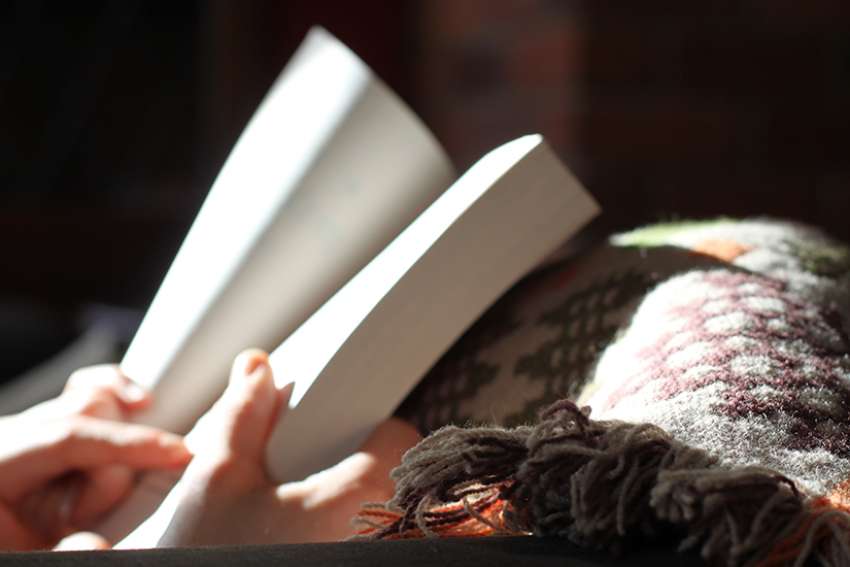This spinal problem allows me to recline on a state-of-the-art heating pad while music floats from my bedside CD player. The only problem is when I get up our cat Emmy, a Maine coon cat who weighs in at 20 pounds-plus and has an iron will, leaps on the heating pad and then I need the jaws of life to pull her away.
At another time in my life my inaction would have made me feel guilty. After all, I am Catholic. But what I have lost in physical action I have at least tried to make up in spiritual progress, small steps though they are.
It has given me time to see how these writings link together into a whole … how they begin to overlap like crashing waves into one great sea.
In the past month I fell into the writings of two great Catholic men and the biography of America’s first saint.
Introduction to Christianity by Pope Benedict XVI has the most misleading book title in publishing history. I tried it a few years ago and it utterly defeated me. Now, with a bit more knowledge, I am finally getting through it, but slowly.
Then there is Pierre Teilhard de Chardin, a Jesuit priest and one of the 20th century’s foremost paleontologists. First I read an excellent biography by Ursula King called The Spirit of Fire: The Life and Vision of Teilhard de Chardin. I then moved onto one of de Chardin’s own books, The Divine Milieu.
The first thing I began to understand from both men is that the stuff of Earth is utterly important to who we are, that there is in a way no difference between the spiritual and material worlds. They are all part of one divine creation.
At the moment of creation, when the Father created the universe out of nothing, the journey of those of us alive today began. Creation, I have begun to understand, is ongoing and our existence — from the ground we stand on to our eventual home in the New Jerusalem to what we do each and every single day — is holy and sustained by God. The fossils that are millions of years old, the dinosaurs now extinct and all those who came before us and those who will come after us are joined into one great explosion of divine creation. We are linked eternally because we all have the same Creator.
We also feed our faith from the very stuff the maker made for us. The bread and wine and the wax of candles, to name just a few of those things, are used to transmit the heavenly to the faithful.
Pope Benedict shows that Catholicism is not only mental exercise; this is something potential converts and those who are already inside but who harbour doubts should pay attention to.
Using our brains to decide whether the faith is true is a process that could go on forever. But it only becomes real and apparent when we take part in it with our bodies.
Pope Benedict writes: “You like to reach faith, but you do not know the way? You want to cure yourself of unbelief, and you ask for a remedy? Take a lesson from those who were earlier racked by doubts like yourself … follow the way by which they began; by acting as if they believed, by taking holy water, by having Masses said and so on. This will bring you quite naturally to believe and stupefy you.”
To this he may have added the feeling of the rosary beads slipping through fingers, the saying of novenas, the simple act of falling to one’s knees and the smell of incense.
“The mere neutral curiosity of the mind that wants to remain uninvolved can never enable one to see.”
For his part, de Chardin’s entire life was defined by seeing the divine in the material world. No matter where he was — including his years as a stretcher-bearer in the First World War — he would find time to hunt for fossils and study the surrounding geology.
He writes in The Divine Milieu:
“God made man that he might seek Him … (and) that self-same God is as pervasive and perceptible as the atmosphere in which we are bathed. He encompasses us on all sides like the world itself.”
It is important to see “God everywhere, to see Him in all that is most hidden, most solid and most ultimate in the world.”
Elizabeth Seton, the first American saint, was born in 1774, long before de Chardin or Benedict. But her conversion confirms what both men would have understood. Her leap from Protestantism to Catholicism was through the faith’s physical manifestations. She barely knew about the dogmas and such when she was received.
One of her biographers, Joan Barthel, noted this about her conversion: “She was following a conviction with no provable basis, a gut feeling that her soul was called to Catholicism as a way to ‘give itself to God alone.’ ”
She was touched by the stuff of Earth that was created by the Father through her Saviour and that proved enough.
(Lewis is a Toronto writer and regular contributor to The Register.)


